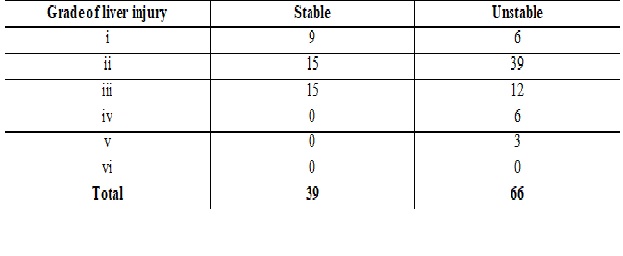Liver injuries- a tertiary rural medical college hospital experience
Abstract
Background: Liver is the most frequently injured solid intra abdominal organ in abdominal trauma. Exsanguination is the main cause of death due to liver trauma. Although non-operative management of hepatic trauma has been utilized with increasing frequency a significant percentage of unstable liver trauma still require operative treatment. The aim of the present study was to examine the results of the operative treatment of patients with unstable liver trauma and prevent prolonged hospital stay. Patients admitted following Liver Trauma in the department of General Surgery, MOSC medical college Hospital, Kolenchery duringthe two year period from January 2013 to January 2015 were included in the study.
Methods: This was a retrospective study of patients with Hepatic trauma admitted to the department of General Surgery, MOSC Medical College Hospital, Kolenchery, Ernakulam from January 2013 to January 2015. The diagnosis of Liver trauma was made pre-operatively with imageology and assessed clinically prior to surgery. Severity of liver injury was graded, treatment details collected and factors contribution to prolonged hospital stay were noted. These patients were later followed up for a period of one year.
Results: During the two year period, 105 patients who were diagnosed to have liver injury were included in the study. Age varied from 12- 75 years. Males outnumbered females (88.5% vs. 11. 43 %). 93 patients were with blunt abdominal trauma (88.5%). 66(62.85%) patients were in shock when they presented to the ER.36 (37.15%) patients were haemo- dynamically stable. 57 patients (54.28%) had associated injuries like multiple rib fractures and splenic injuries. Exploratory laparotomy and control of bleeding, hepatorapphy and local debridement was done. Nine patientsrequired relaparotomy and omental packing. Fifteen patients succumbed to liver injury. The post-operative period was delayed in those patients who had other visceral injury. Follow up of cases for a period of 1 year was done and there was no late complication like intra-abdominal abscess, coagulopathy, bile leak or hepatic abscess.
Conclusion: Emergency laparotomy with hemostasis and repair liver injury in unstable cases and select stable cases savestime and life of the patient, it is cost effective and hospital stay and systemic complications are minimal
Downloads
References
2. Gourgiotis S, Vougas V, Germanos S, Dimopoulos N, Bolanis I, Drakopoulos S, et al. Operative and nonoperative management of blunt hepatic trauma in adults: a single-center report. J Hepatobiliary Pancreat Surg. 14(4):387–91.[pubmed]
3. Jiang H, Wang J. Emergency strategies and trends in the management of liver trauma. Front Med. 2012 Sep;6 (3): 225–33.[pubmed]
4. Coughlin PA, Stringer MD, Lodge JPA, Pollard SG, Prasad KR, Toogood GJ. Management of blunt liver trauma in a tertiary referral centre. BJS. 91 (3):317–21.[pubmed]
5. Stassen NA, Bhullar I, Cheng JD, Crandall M, Friese R, Guillamondegui O, et al. Nonoperative management of blunt hepatic injury: An Eastern Association for the Surgery of Trauma practice management guideline. J Trauma Acute Care Surg. 2012 Nov;73:S288–93.[pubmed]
6. Asfar S, Khoursheed M, Al-Saleh M, Alfawaz AA, Farghaly MM, Nur AM, et al. Management of Liver Trauma in Kuwait. Med Princ Pract. 2014;23(2):160–6.[pubmed]
7. Doklestic K, Djukic V, Ivancevic N, Gregoric P, Loncar Z, Stefanovic B, et al. Severe blunt hepatic trauma in polytrauma patient: Management and outcome. Srp Arh Celok Lek. 2015;143(7–8):416–22.[pubmed]
8. Parks RW, Chrysos E, Diamond T. Management of liver trauma. British journal of surgery. 1999 Sep 1;86 (9): 1121-35.[pubmed]
9. Stracieri LD da S, Scarpelini S. Hepatic injury. Acta Cir Bras. 2006;21(suppl 1):85–8.[pubmed]
10.Trunkey DD, Shires GT, Mc Clelland R. Management of liver trauma in 811 consecutive patients. Ann Surg. 1974 May;179(5):722–8.[pubmed]
11. Vatanaprasan T. Operative Treatment of Hepatic Trauma in Vachira Phuket Hospital. 2005;88:11.[pubmed]
12. Feliciano DV. Continuing evolution in the approach to severe liver trauma. Annals of surgery. 1992 Nov;216(5):521.[pubmed]
13.Badger SA, Barclay R, Campbell P, Mole DJ, Diamond T. Management of Liver Trauma. World J Surg. 2009 Dec;33(12):2522–37.[pubmed]
14. Cox EF, Flancbaum L, Dauterive AH, Paulson RL. Blunt trauma to the liver. Analysis of management and mortality in 323 consecutive patients. Annals of surgery. 1988 Feb;207(2):126.[pubmed]
15. Hollands MJ, Little JM. The role of hepatic resection in the management of blunt liver trauma. World journal of surgery. 1990 Jul 1;14(4):478-82.[pubmed]
16. Stone HH, Lamb JM. Use of pedicled omentum as an autogenous pack for control of hemorrhage in major injuries of the liver. Surg Gynecol Obstet. 1975 Jul;141(1):92–4.[pubmed]
17. Pachter HL, Spencer FC. The management of complex hepatic trauma. Phila Saunders. 1983;241–249.
18. Feliciano DV, Mattox KL, Burch JM, Bitondo CG, Jordan JG. Packing for control of hepatic hemorrhage. J Trauma. 1986;26(8):738–743.[pubmed]
19. Reed 2nd RL, Merrell RC, Meyers WC, Fischer RP. Continuing evolution in the approach to severe liver trauma. Ann Surg. 1992;216(5):524.[pubmed]



 OAI - Open Archives Initiative
OAI - Open Archives Initiative


















 Therapoid
Therapoid

